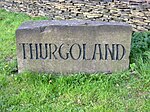Huskar Pit
1838 disasters in the United Kingdom1838 in EnglandCoal mines in the Metropolitan Borough of BarnsleyCoal mining disasters in EnglandDisasters in Yorkshire ... and 3 more
History of BarnsleyUnderground mines in EnglandUse British English from July 2020

Huskar Pit was a coal mine on the South Yorkshire Coalfield, sunk to work the Silkstone seam. It was located in Nabs Wood, outside the village of Silkstone Common, in the then West Riding of Yorkshire. It was connected to the Barnsley Canal by the Silkstone Waggonway. Huskar was the scene of a notorious pit disaster in 4 July 1838.
Excerpt from the Wikipedia article Huskar Pit (License: CC BY-SA 3.0, Authors, Images).Huskar Pit
Nether Royd View,
Geographical coordinates (GPS) Address Nearby Places Show on map
Geographical coordinates (GPS)
| Latitude | Longitude |
|---|---|
| N 53.529722222222 ° | E -1.5578055555556 ° |
Address
Site Of Huskar 1838 Day Hole
Nether Royd View
S75 4QQ , Silkstone
England, United Kingdom
Open on Google Maps








